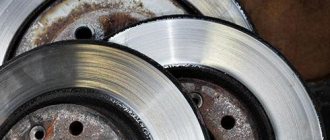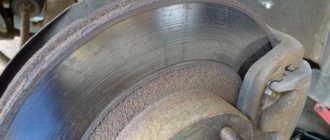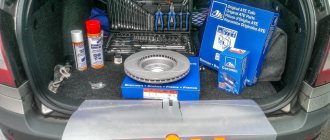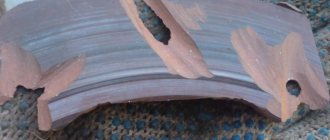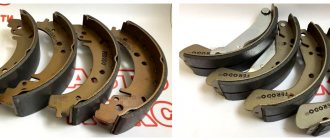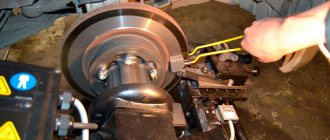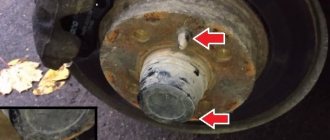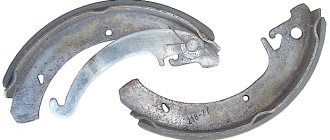Why is it so important to monitor the condition of your brake discs?
Discs and pads are subject to high loads while driving. Like any other car part, they tend to wear out. This in turn can affect the overall safety and reliability of the vehicle. Consequently, every car enthusiast must calculate the most important parameter so that nothing serious happens on the road.
Brake disc covered with erosion
Urgency
Now it’s time to answer the main question: how long do brake pads last on a car and when should they be changed? What affects their wear and the maximum mileage that is possible for a car without maintenance?
One of the fundamental factors that affects how long a car runs on the same brake pads is driving style. It's no secret that exactly how the braking is done and how often the driver has to press the pedal directly affects the service life of the brake pads and how long they last from replacement to replacement.
Obviously, the less often you have to brake, the longer the service life of the brake pads and the longer they last. However, we should not forget that the force that the pads exert on the disc has a very significant effect on the service life of a particular consumable. In this regard, to save money, it is recommended to brake as smoothly as possible and only at those moments when it is really necessary. It is worth noting that the difference in how long the pads travel with a calm and aggressive driving style is significant, and in some cases it reaches an impressive 35–40%.
Also, the quality of the consumable itself has a strong influence on how long the pads last on the car and the service mileage. It has long been known that, in order to save money, in the production of the most inexpensive pads, materials are used that not only wear out quickly, even if the driving style has always remained quite smooth, but also have weak adhesion properties. There is no need to remind once again that such a short service life of brake pads directly affects the safety of the driver and passengers, and it is especially important to understand this for owners of cars with high mileage, the wear of which is significant.
Inspection of pads at a service station or yourself
For inspection, you will need to remove the corresponding wheel. Those. you need a jack or lift (pit). You will also need a caliper and a ruler to measure the remaining friction layer.
Typically, the minimum permissible thickness of the residual layer is 1.5 - 2 mm.
A brake disc with deep grooves also indicates severe wear. For discs, the minimum permissible thickness is 10-12 mm.
The wear of the brake pads in the rear brake drums is determined through a special inspection hole in the drum body; if there is none, then you will have to remove the entire brake drum and use a ruler or caliper to measure the remaining thickness of the friction layer. Indirectly, the condition of the rear pads is related to the handbrake, when it stops holding or operates on the last click - this indicates increased wear.
How to understand that it is time to change brake pads without direct access to them
Having figured out at what mileage the pads should be replaced with new ones, let’s look at the main symptoms of wear using methods that do not require special tools and are accessible to everyone.
- If you have alloy wheels and disc brakes, you can sometimes observe the pads directly:
- The simplest option. The pad wear indicator will work. There are electronic and mechanical. Electronic is a light on the dashboard. It is triggered by a short circuit on the sensor when it touches the metal.
Attention! False alarms are possible due to short circuits due to moisture.
The principle of a mechanical indicator is even simpler: when braking, a characteristic whistle of the indicator will be heard.If there is no indicator, you will hear the sounds of metal rubbing against metal as the friction layer is destroyed or abraded.
- Pay attention to the amount of brake fluid. As a rule, it is filled to the top. In the absence of leaks, the drop in level is caused by increased piston stroke due to pad wear. A critical level drop is also indicated by a warning lamp.
- When braking heavily, you can feel a vibration in the steering wheel. Usually occurs due to deformation of the pad or brake disc itself. You can carry out a test: after accelerating to 80 kilometers, perform emergency braking (make sure that no one is behind you!) - if there is a beating on the pedals, a pull to the side, then you need to replace the pads and, very likely, the discs as well.
- The braking distance to a complete stop increased, the brake pedal began to grab at the end of the stroke, and other oddities appeared in the operation of the brake pedal.
- There is a pull to the side, and skidding occurs on slippery surfaces due to uneven braking.
Instructions for calculating fuel consumption. Read it, it will help you save money.
Proper battery charging will save you in winter. Find out how to do it correctly and quickly.
Do you want to laugh? Women driving is something.
Other reasons for replacing pads
In addition to situations with critical wear, it is necessary to change brake pads in the following cases:
- the thickness of the friction material is more than 5 mm, but the lining itself has begun to peel off from the steel base;
- cracks and chips appeared on the surface, the material began to crumble;
- stains of oil or brake fluid that reduce friction properties were found on the parts;
- when the brake drum or disc is replaced.
Another reason for replacement is due to the abundance of low-quality fakes on the automotive spare parts market . New pads purchased from an unreliable retail outlet begin to squeak or squeak terribly after 1-2 thousand km, although the working part is still far from completely worn out. The culprit is the material of the part, whose hardness is comparable to metal, causing the surface to “slick” and create a creaking sound. If the elements made from unknown materials are not replaced, then the production on the brake discs will increase sharply.
Many modern cars are equipped with special sensors that detect a decrease in the thickness of the friction layer and send a signal to the driver when it reaches a critical level. This is also a reason to remove parts with worn linings and install new ones.
True, the sensors often become clogged with dirt and lose their functionality, so it wouldn’t hurt for the car owner to check the condition of the brakes himself.
Wear limit
Every car enthusiast must know the permissible wear limit for brake discs on his car. Many drivers use their cars to the limit. When listening to the squeak of friction of the pads on the brake disc.
Only then do some drivers think about a replacement. When using the braking system at maximum limits, an emergency situation on the road is created. The manufacturer himself sets the maximum permissible standards.
Displaying markings using one of two methods.
- Inscription on the rim of the disc
- Mark on the recess at the end of the disk on its inner side.
The standard size of brake disc thickness can be measured with a caliper. Not every driver has such a measuring device. You can check the thickness of the brake disc with your own finger.
Every brand of car has its own permissible wear limit. The reasons for increased wear depend on the vehicle's engine. In winter, the requirements for braking properties increase. Reducing the thickness of the disk by two to three millimeters from the nominal dimensions is no longer acceptable.
Wear occurs as a result of friction between brake pads and discs lubricated with a friction compound. Wear is affected by the functioning of the entire brake system, the technical operating conditions of the car, and even the driving style.
The operation of the system is affected by the seasonality of the weather, the interaction of soil and sand and moisture, and the poor condition of the road surface.
Recommendations for selection
Rule one and very important: you cannot change the front or rear brake pads one by one. It is necessary to install a set of new elements on the front or rear axle, otherwise when braking the car may seriously drift to the side. Even when one pad is worn out, all four must be replaced . As a temporary option, it is possible to install 2 new parts on one rear wheel.
When choosing new pads in the store, use the following recommendations:
- Products must match the car model and be sold in high-quality packaging with included instructions. The inscriptions on the box are clear and without errors indicating Chinese origin.
- Make sure that the friction material is the same color, without foreign inclusions.
- The surface pressed against the plane of the disk must be flat. Small chips along the edges and depressions are allowed if they occupy no more than 1% of the total area of the working plane.
- Cracks at the interface between metal and friction material are unacceptable.
Ideally, you should buy original products in original packaging. This will save you from unpleasant surprises, unscheduled replacements and emergency situations when operating your car.
Stages and features of diagnosis
The measuring stage of the test involves the use of a caliper, which will help make thickness measurements. At approximately 5-8 points, moving around the disk, measure the thickness. If it varies along the radius of the part, there are signs of curvature and uneven wear.
Check the information from the manufacturer to understand whether the wear limit has already reached or not. I cannot say which indicators are correct and which are not, since different discs have their own wear limits.
Then a visual inspection is carried out. The disc should be examined for cuts, chips, dents, scratches and other defects on its surfaces. If they are, the spare part will have to be replaced.
Do not forget about the rule of pairwise replacement on the same axis. That is, when the left front disc is changed, the front right one also changes at the same time.
If you want to assess the condition of the elements without removing the wheels, this can be done by checking while driving. With severe wear, characteristic signs appear:
- the car brakes jerkily;
- a grinding sound appears;
- there is a squeaking sound when you press the brake;
- other extraneous sounds are heard;
- the driver feels a beat on the steering wheel;
- the beating is also felt in the gas pedal;
- When the brake pedal is pressed, the braking system is locked.
I strongly do not recommend waiting for such symptoms to appear. It’s better to periodically do simple diagnostics in your garage through visual inspection and measurement. This is usually done every 10-15 thousand kilometers, if wear symptoms do not appear earlier.
..
How are drum brakes different from disc brakes?
One of the disadvantages of drum mechanisms compared to disk ones is the lack of a self-cleaning effect. Wear products from the brake pads remain inside the drum and leave characteristic marks on the working surfaces of the friction elements.
Due to the abundance of wear products, characteristic grooves formed on the working surface of the pad. The actual wear of the linings was about 30%.
Due to the abundance of wear products, characteristic grooves formed on the working surface of the pad. The actual wear of the linings was about 30%.
Editorial Kalina is often used to participate in various competitions. That is, the conditions of its operation can be called difficult. However, to our surprise, the wear on the original pads turned out to be small - about 30%. Probably the reason is that the car has a relatively small mass, and its dynamic performance is not outstanding.
Deep grooves on the working surface of the drums are the result of exposure to wear products.
Deep grooves on the working surface of the drums are the result of exposure to wear products.
Alas, wear products have significantly damaged the working surfaces of the linings and drums. This can't be fixed. The next time you replace the pads, you will also have to update the drums, otherwise they will immediately damage the new pads. However, there is nothing criminal in the further operation of the car in this form. The reduction in rear brake performance is not noticeable even when driving on a race track. In general, drums, like discs, can survive two sets of friction linings.
How to independently assess the wear of brake pads and discs?
Photo: from the author’s archive
